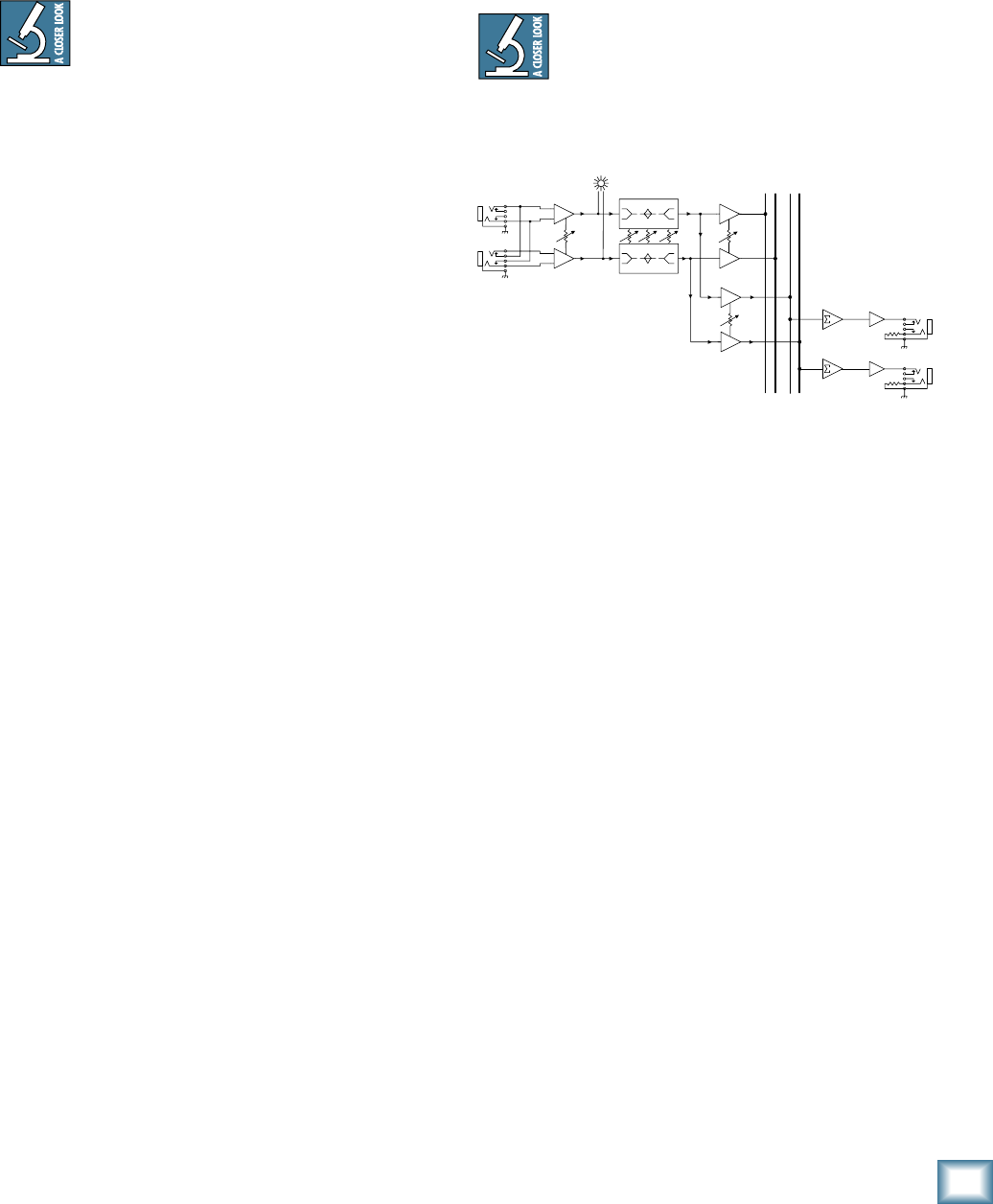
1
Owner’s Manual
Owner’s Manual
-BAND EQ
The U.420 has 3-band equalization at carefully
selected points — low shelving at 300 Hz, mid peaking
at 1 kHz, and high shelving at 4 kHz. “Shelving” means
that the circuitry boosts or cuts all frequencies past the
specified frequency. For example, rotating the low EQ
knob clockwise will boost the bass at 300 Hz and below.
“Peaking” means that certain frequencies form a “hill”
around the center frequency — 1 kHz in the case of the
mid EQ.
Be careful with the EQ, or you can really upset
things. We’ve designed a lot of boost and cut
into each equalizer circuit, because we know
everyone will occasionally need that. But if
you max the EQs on every channel, you’ll get mix mush.
Equalize subtly and use the left sides of the knobs
(cut), as well as the right (boost). You can create many
interesting and useful EQ changes by turning the knobs
down and adjusting the level [17] up if needed.
If all the EQ controls in a channel are turned down to
the kill position, then that channel is effectively muted.
(Word: DJs find it very useful to have EQ controls with a
kill position, in their fast-paced beat-based world.)
1. HIGH EQ
This gives up to 10 dB of boost for the frequency range
above 4 kHz, and the highs are muted in the kill posi-
tion. In the center position U, high EQ has no effect.
Use it to add sizzle to cymbals, and an overall sense
of transparency, or edge to keyboards, vocals, guitar and
bacon frying. Turn it down a little to reduce sibilance, or
to hide tape hiss.
14. MID EQ
This gives up to 10 dB of boost for frequencies cen-
tered around 1 kHz, and the mid range is muted in the
kill position. In the center position U, mid EQ has no
effect.
Midrange EQ is often thought of as the most dynamic,
because the frequencies that define any particular
sound are almost always found in this range.
15. LOW EQ
This gives up to 10 dB of boost for the frequency range
below 300 Hz, and the lows are muted in the kill posi-
tion. In the center position U, low EQ has no effect.
The frequency range below 300 Hz represents the
realm of bass drums, bass guitar, fat synth patches, and
lower down to some really serious male singers.
1. AUX
These stereo controls allow you to adjust how much of
the channel signal is added to the aux bus. The aux bus
contains the sum of all channels whose aux controls are
set to more than minimum.
The aux bus feeds the aux outputs [5], typically out
to an external processor. Each channel’s stereo signal
retains it’s stereo image as it is sent to the aux bus.
This is great for keyboard players who work with stereo
sounds from stereo effects processors.
A look at the block diagram may shed some
light on the aux signal path, but you can skip
this part if you like. The following diagram
shows just one channel, but each channel
adds to the aux bus and main bus in the same way.
The channel signals go through the preamplifier and
into the EQ. The level control [17] allows you to adjust
how much of the channel appears on the main mix bus.
The aux control [16] allows you to adjust how much of
each channel appears on the aux bus.
• The aux output is affected by the gain, EQ, and
aux level of each channel.
• The aux output is not affected by the level
control of each channel, and it is independent
of the main mix bus.
For an example, you could set up a stage monitor for
the guitar player. Connect an amplifier or a powered
monitor to the aux outputs [5]. Set all aux level con-
trols to minimum, then turn up the guitar channel’s aux
level to suit. Any adjustments of the level [17] or main
level [23] will not affect the stage monitor level, so your
guitar player will be happy, and that is always a good
thing. Mark that one on your calender as a special day.
17. LEVEL
These level controls allow you to adjust how much of
the channel signals appear on the main mix bus. They
have no effect on the level of signals going onto the
aux bus. Adjust these carefully to acheive a nice blend
in your main system and headphones. Turn down any
unused channels.
L
R
Main
Level
Aux Out L
Aux L
L
R
3-Band EQ
Gain
LO
HI
MID
LO
HIMID
Aux Out R
Aux R
Aux
Level Set
Aux
Sum
L
R


















